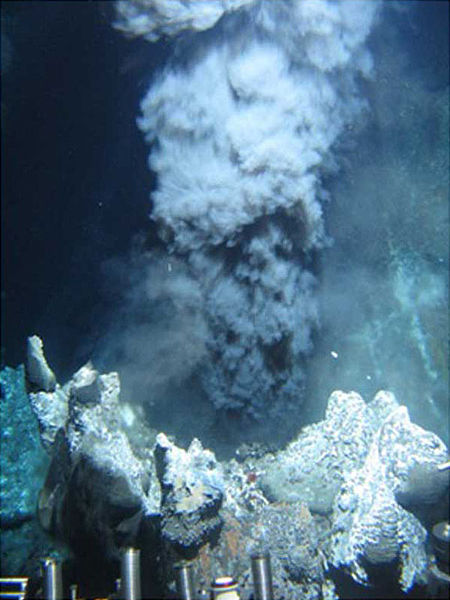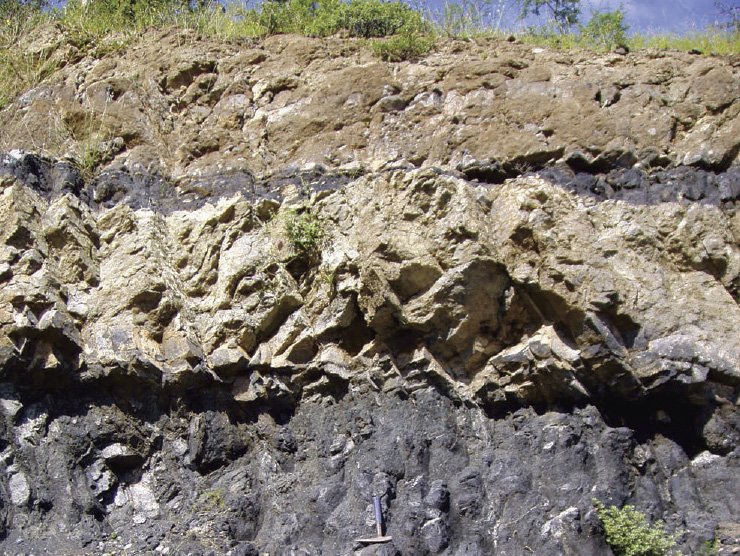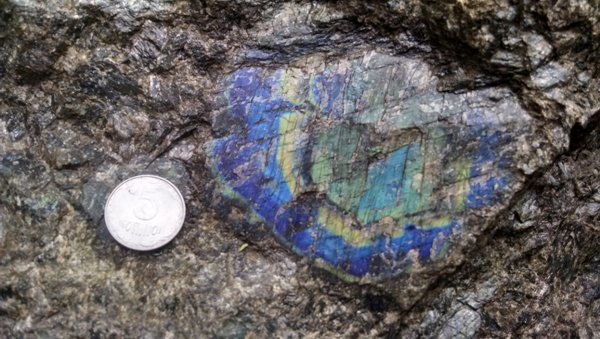Thorn is not really in the running as an economic primary silver deposit and it’s no surprise that they’re talking about the sediment-hosted gold prospect: That could prove more interesting in the long run.
[box type=”info” align=”aligncenter” ]Disclaimer: This is an editorial review of a public mining company press release and is not an endorsement. It may include opinions or points of view that may not be shared by the companies mentioned in the release. The editorial comments are highlighted so as to be easily separated from the release text and portions of the release not affecting this review may be deleted. [/box]
October 29, 2014 – Brixton Metals Corporation (TSXV: BBB) (the “Company” or “Brixton”) is pleased to announce its independent maiden resource estimate of 21.5 million ounces of silver equivalent as an inferred resource at its 100% owned Thorn project located in northwestern B.C. SRK Consulting Canada Inc., has provided the inferred resource estimate based on approximately 15,160 metres of drilling. The resource estimate combines three mineralized zones; Oban, Talisker and Glenfiddich.
[box type=”note” align=”aligncenter” ]
Earlier this week we talked about Kaminak’s Coffee project and their endless string of coffee-related zone and project names. Brixton Metals also has a themed naming convention: All of their mineralized zone are named for brands of single malt Scotch. In retrospect, it’s probably best we talk about them on a Friday. Starting the week with Scotch and ending with coffee just wouldn’t have felt right.
Brixton is solely focused on it’s Thorn project in Northern BC, Canada and after more than 15,000 meters of diamond drilling, the company is publishing it’s first NI 43-101 compliant resource estimate for the property.
[/box]
Highlights of 2014 Results
- The 3 zones combined total 21.5Moz AgEq of inferred resource
- All mineralized zones remain open for expansion
- Most of the inferred resource is open pit material
- The sediment-hosted gold discovery in 2014 provides significant upside potential
- Abundant high-grade gold-silver targets remain to be tested
Chairman and CEO of Brixton Metals, Gary Thompson stated, “We are excited to have completed our first resource estimate at the Thorn project. This inferred resource is based on limited drilling and importantly all mineralized zones remain open for expansion. In addition, during 2014, Brixton discovered a sediment hosted-gold zone which represents a large scale gold target as previously stated in the Company’s News Release July 29, 2014 and in general has had a high rate of discovery on the project. Mr. Thompson further stated that, “The Company currently has approximately $1.2 million in working capital”.
[box type=”note” align=”aligncenter” ]
While gold deposits may host only gold, silver deposits often include significant lead, zinc and other metals. Gold often occurs as “free gold” since it doesn’t easily form chemical bonds with other elements. This is why it maintains it’s lustre and resists corrosion. Silver is much more reactive and will form bonds with other elements. It does occur in deposits as free silver, but also as sulfide minerals and within other base-metal sulfides. So like most other silver deposits, the Thorn deposits are polymetallic – with silver, lead, zinc, copper and gold.
[/box]
Table 1.1: Inferred Mineral Resource Statement, Thorn Project, British Columbia, SRK Consulting (Canada) Inc., October 28, 2014.

- The in-pit portion is reported at a dollar equivalent cut-off value of US $15 per tonne within a Whittle shell and $50 per tonne for an underground portion of the Oban deposit. The Whittle shells were designed based on a slope angle of 55 degrees and 90% recovery for all metals. The block models are 10 x 10 x 10 m, 5 x 10 x 5 m, and 5 x 10 x 5 m for Oban, Glenfiddich, and Talisker respectively. The Whittle shell for Oban does not include Copper. The Whittle shells for Glenfiddich and Talisker do not include Lead or Zinc.
- Dollar and Silver Equivalents are based on US $20 Silver, $1200 Gold, $3 Copper, $1 Lead, and $1 Zinc, with metal recoveries of 90%. Copper is not included in the Oban estimates. Lead and zinc are not included in the Glenfiddich and Talisker estimates.
[box type=”note” align=”aligncenter” ]
Since the resource is polymetallic, the total silver ounces and grade are expressed as AgEq (silver equivalent). Equivalent grades are often employed where multiple commodities are involved, but making these calculations requires the use of market prices and can they can fluctuate based on changing market conditions. It can be tough to make sense of a “equivalents” when it comes to assessing a project. For example, the company has used a gold price of $1200 /oz and a silver price of $20 per ounce in their calculations. Let’s say we change that to $1100 and $15. The result would actually be an increase in the AgEq grade since there are more $15 units in the final result and the contribution of the other base metals would be higher.
Confused yet? Me too.
To further complicate matters, the company is using a dollar-value as the minimum cut-off instead of a cut-off ore grade. Again, this is because the deposit is poly-metallic: Ore below silver cut-off grade, for example, might still have economic zinc or gold or whatever. But then why not at least use a AgEq as a minimum cut-off? A $15 cut-off at today’s silver prices is around 0.85 oz/ton or about 29 g/t silver.
So how do we assess this as a resource? Perhaps the simplest way to do so might be to compare these results to other primary silver mines. In general, primary silver mine are underground operations focused on following silver-rich veins. Typical mine grades range from 200 to 400+ g/t, but there are some operating at under 200 g/t: Let’s look at the average and cut-off grades of a few lower grade silver mines. Since there are no primary silver mines operating in Canada, we’ll look south. Here are a few examples of mines with grades of less than 200 g/t silver:
- Silver Standard’s Pirquitas Mine in Argentina is an open pit operation with an average grade of 180.8 g/t silver and 0.51% zinc (Proven) and 169.1 g/t silver, 1.03% zinc (Probable). About 75 million ounces of silver (Proven and Probable)
- Fortuna Silver Mine’s Caylloma Mine in Peru has Proven+Probable reserves grading at 137 g/t silver, 0.40 g/t gold and 1.69% lead and 2.49% zinc. Their San Jose in Mexico mine grades 225 g/t silver and 1.75 g/t gold. Both mines are underground.
- The Cannington Mine in Australia is one of the world’s largest, but reserves and resources have been steadily declining as the mine nears the end of it’s life. As of 2012, silver grades were 248 g/t measured, 149 g/t indicated and 125 g/t inferred. Lead values are around 5% and zinc values around 3%.
At this point, with ~35 g/t silver, 0.51 g/t gold and ~1% total base metals it looks like Brixton’s Thorn is not really in the running as an economic primary silver deposit and it’s no surprise that they’re talking about the sediment-hosted gold prospect: That could prove more interesting in the long run. Despite the 15,000+ meters drilled, the Thorn property is a relatively early stage exploration project with potential for other deposit types and mineralization styles.
[/box]
The resource model is based on 35 historical drill holes and 64 recent drill holes completed by Brixton. Most of the drilling by Brixton has concentrated on the Oban Zone with the majority of this taking place during the 2012-2013 exploration programmes. Of the total drilling, 11,000 metres was directed to the Oban deposit, 2,160 metres was within the Talisker Zone and 2,000 metres in the Glenfiddich Zone.
SRK Consulting (Canada) Inc. states on conclusion,” that the Thorn Project to has future potential for developing additional mineral resources. A careful drill program could identify additional inferred mineral resources and possibly upgrade some of the inferred resources to an indicated category“.
SRK recommends the following:
- Continued specific gravity sampling.
- Continued careful monitoring of QA/QC sample results.
- Additional drilling to extend the open pit resource for the Oban Zone, especially to the south east.
- Additional drilling to extend the Glenfiddich and Talisker Zones.
- Metallurgical testing for all zones with the focus on the Oban Zone.
SRK has classified the mineral resources into the Inferred category (Table 1.1). For both the Talisker and Glenfiddich zones, the drill hole spacing, at approximately 75 metres, is wide-spaced to support resource classification higher than inferred. In addition, a part of the resource in those two deposits is based on historic drilling, for which there is no documentation of sampling practices or analytical quality control procedures. For all zones, including the Oban deposit, there has not been metallurgical work to determine metal recoveries. In particular, and with requisite metallurgical testwork, we believe that a portion of the Oban resource could upgrade in classification to indicated in the future.
[box type=”note” align=”aligncenter” ]
It’s worth noting that some of the drill results used in the resource calculation are from historic holes whose QA/QC are undocumented. In addition, there has been no work done on metal recoveries. That said, Brixton should get credit for using 90% metal recoveries in their resource calculation. Most companies, especially in early stage resource calculations, assume unrealistic 100 % recoveries. The company is also telling us that they have closely spaced their drill holes with the hope of ultimately upgrading their resource to indicated or measured resources.
[/box]
A copy of the NI-43-101 report shall be made available upon receipt.
The resource estimate was completed by Tessa Scott under the supervision of Marek Nowak, P.Eng. APEGBC#119958 an “independent competent person” as this term is defined in NI 43-101 and has reviewed and approved this news release.
About Brixton Metals and its Thorn Project
Brixton is an exploration company focused on the advancement of high-grade precious metal assets to feasibility. Brixton’s Thorn project hosts a district scale Triassic to Cretaceous volcanoplutonic complex with several styles of mineralization related to porphyry and epithermal environments. Targets include sediment hosted gold, high-grade silver-gold-lead-zinc-bearing diatreme-breccia zones, high-grade gold-silver-copper veins and porphyry copper-gold-silver. The 28,000-hectare Thorn Project is located in the Sutlahine River area of northwestern British Columbia, Canada, approximately 105 km ENE from Juneau, AK.
[box type=”note” align=”aligncenter” ]
Brixton is currently trading at a 52 week low of $0.11.
[/box]
[box type=”success” align=”aligncenter” ]Have a company or release you’d like us to look at? Let us know though our contact page, through Google+, Twitter or Facebook.[/box]







I’ll get back to you later this week. Subeconomic.
I’ll get back to you later this week. Subeconomic.